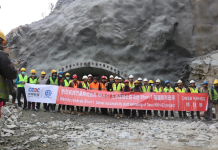BEIJING: One scorching summer day in August, a group of high-energy physicists installed a strange array of experimental equipment on the roof of a high-school in the eastern Chinese city of Taizhou.
The devices, including a plastic scintillator, a photoconductive detector and a photomultiplier, are not the ordinary sort of apparatus found in a school laboratory. They’re capable of detecting cosmic rays from outer space, gathering data for an important frontier area of scientific research.
The tiny observatory installed at Jiangyan Middle School is part of a network called Campus Cosmic-ray Observation Collaboration (CCOC) that allows high-school and undergraduate students in China to understand the mysterious phenomenon of radiation from deep space. Research on such rays may help decode the origins of the universe, solar activities and the Earth’s space environment.
He Huihai, who led a technical group for the project, is also a scientist working at the Large High Altitude Air Shower Observatory (LHAASO), one of the country’s key national science and technology infrastructure facilities.
LHAASO, which is under construction in southwest China’s Sichuan Province, has already detected a dozen ultra-high-energy cosmic accelerators within the Milky Way, a find that could revolutionize our understanding of the galaxy.
Cosmic rays, along with neutrinos and gravitational waves, have become a new tool for physicists and astronomers to unravel the secrets of the universe. –Agencies






